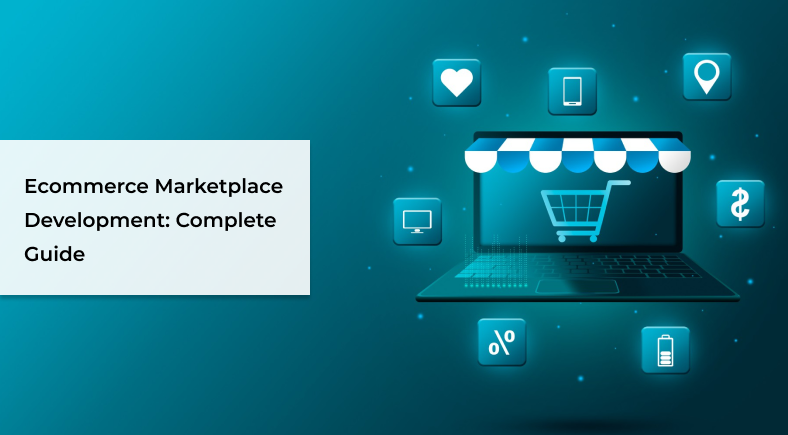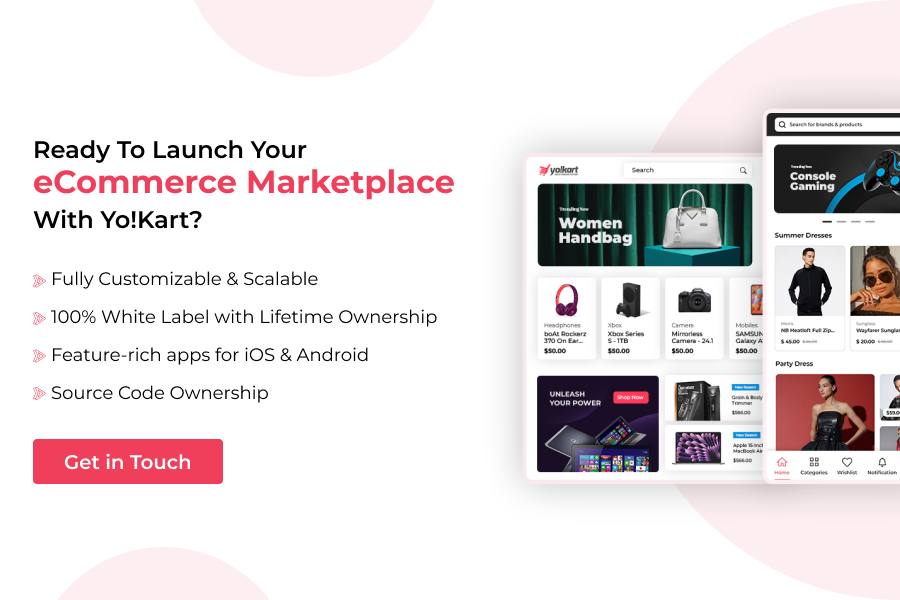The ecommerce marketplace industry has grown tremendously over the past decade, with eCommerce sales worldwide expected to exceed $8 trillion by 2027, with more than 2.86 billion people actively shopping online. This dynamic shift presents significant opportunities for entrepreneurs and businesses to tap into an ever-expanding digital ecosystem.
However, successful eCommerce marketplace development requires a well-thought-out strategy that integrates cutting-edge technology, strong business planning, and effective marketing. Whether you’re looking to create a niche marketplace or a broad platform that caters to a wide variety of products and services, understanding the core components of eCommerce marketplace development is essential.
This complete guide will walk you through all the essential steps, features, and considerations for a successful eCommerce marketplace development.
Table of Contents
What is an eCommerce Marketplace?
An ecommerce marketplace is an online platform that allows multiple independent sellers to list and sell a broad spectrum of products and services to a large, diverse audience—all within a single, unified platform.
Unlike traditional eCommerce websites that focus on a single brand or retailer, a marketplace connects various vendors, offering a wide variety of goods without managing the inventory directly. Marketplaces like Amazon, eBay, Etsy, and Alibaba have become some of the most popular and successful examples in the digital retail landscape. These platforms bring together buyers and sellers, offering a broad range of products across categories such as electronics, fashion, home goods, and more, all while providing sellers with a unique opportunity to reach a vast customer base.
These marketplaces offer buyers the convenience of buying from a single platform, often featuring competitive pricing, a variety of shipping options, and an easy, user-friendly experience.
Why eCommerce Marketplace Development is a Smart Business Move?
eCommerce marketplace development offers numerous advantages that help both marketplace owners and sellers thrive in a competitive digital landscape. From cost efficiency to global reach, here are the key benefits of building an eCommerce marketplace:
- Diverse Product Range: By hosting multiple sellers, marketplaces naturally offer a wide variety of products. This attracts a larger customer base since buyers can find everything in one place, improving user experience and boosting customer retention.
- Scalability and Growth Opportunities: An eCommerce marketplace allows rapid scaling by adding more sellers and products without significant inventory investment. This model supports exponential growth while keeping operational costs manageable, making it easier to expand into new regions or niches.
- Low Inventory Risk: Unlike traditional eCommerce models, eCommerce marketplaces don’t require maintaining stock. Sellers manage their own inventory, while you earn revenue through commissions. This drastically reduces financial risk, eliminates storage costs, and ensures more flexibility in business operations.
- Multiple Revenue Streams: Marketplaces generate income through multiple channels like commissions, subscription fees, featured listings, advertisements, and more. This diversified revenue model creates stable earnings and reduces dependency on a single source of income, increasing profitability.
- Improved Customer Engagement: Marketplaces attract buyers with product variety, competitive pricing, and honest reviews. User-generated content like ratings and feedback also improves trust and engagement, helping build a stronger customer base and boosting organic growth over time.
Popular eCommerce Marketplaces Shaping Digital Commerce
When it comes to online shopping, the eCommerce industry is dominated by a few powerful eCommerce marketplaces that provide unmatched product variety and serve diverse audiences. Here are some of the most popular eCommerce marketplaces shaping the digital commerce landscape today:
1. Amazon: Amazon is the world’s largest online marketplace, known for its vast product selection, fast delivery, and customer-centric approach. With millions of third-party sellers, it offers global reach, seamless logistics, and innovative features like Prime membership and AI-powered recommendations.
- Founded In: 1994
- Annual Revenue: $670.038 billion
- Active Buyers: 310 million
2. eBay: eBay pioneered the online auction model, allowing buyers to bid on products or purchase instantly. The platform caters to both new and used products, offering niche collectibles and rare goods, while maintaining a strong international presence for sellers worldwide.
- Founded In: 1995
- Annual Revenue: $10.470 billion
- Active Buyers: 134 million
3. Etsy: Etsy specializes in handmade, vintage, and unique goods, attracting creative entrepreneurs and craft enthusiasts. Its strong community-driven approach helps small businesses thrive, while buyers enjoy personalized, one-of-a-kind products not easily found on mainstream retail platforms.
- Founded In: 2005
- Annual Revenue: $2.99 billion
- Active Buyers: 88.50 million
4. Alibaba: Alibaba is a leading B2B eCommerce marketplace connecting global buyers with Chinese wholesalers and manufacturers. Known for bulk orders and cost-effective sourcing, it empowers businesses worldwide to access products directly from suppliers, driving global trade and supply chain efficiency.
- Founded In: 1999
- Annual Revenue: $137.30 billion
- Active Buyers: 1 billion+
5. Walmart Marketplace: Walmart Marketplace enables third-party sellers to showcase products alongside Walmart’s inventory, benefiting from the brand’s massive retail presence. With competitive pricing and access to Walmart’s loyal customer base, it has grown into a strong competitor to Amazon in the US.
- Founded In: 2009
- Annual Revenue: $693.153 billion
- Active Buyers: 120 million
Launch an eCommerce Marketplace Similar to Amazon, Alibaba, or Walmart
Essential Steps to Build an Ecommerce Marketplace
Building a successful eCommerce marketplace involves multiple stages, each crucial for creating a platform that is user-friendly, scalable, and attractive to both buyers and sellers. Here’s an overview of the key steps you’ll need to follow for a successful eCommerce marketplace development:
1. Market Research and Analysis:
Conduct comprehensive research to understand your target audience, competitors, and current market trends. Identify potential niches, high-demand products, and gaps that your marketplace can fill. Use surveys, focus groups, and analytics tools to collect actionable data. A well-researched market strategy ensures your platform meets user expectations and stands out in a competitive landscape.
2. Choose Your Business Model:
Define a clear and sustainable revenue model for your marketplace. Popular options include:
- Commission-Based: The platform earns a percentage of each sale made through the platform.
- Subscription-Based: Sellers pay recurring fees for exclusive benefits, such as reduced commissions, access to premium features, and more.
- Freemium Model: Basic access and listing to a certain limit is free, with premium features offered at a cost.
- Featured Listings: Sellers can pay to have their products or shops featured at the top of search results or on prominent pages.
- Advertisements: Allow third-party businesses to advertise their products or services on the platform, generating additional revenue.
- Partnerships: Collaborate with other brands or influencers, offering co-branded opportunities or cross-promotions to drive traffic and revenue.
Choosing the right model ensures profitability while providing flexibility for growth and scalability.
3. Define Key Features of Ecommerce Marketplace:
To attract and retain both buyers and sellers, your platform should include:
- Intuitive User Interface: Simple navigation and visually appealing design for an enjoyable user experience.
- Seller Dashboard: Provide dedicated seller dashboards for managing listings, tracking sales, and analyzing performance metrics efficiently.
- Product Management System: Easy uploading, editing, and categorization of inventory for seamless product management.
- Streamlined Checkout: A smooth, reliable, and secure payment process that enhances customer satisfaction.
- Multiple Payment Options: Support various payment methods like credit/debit cards, digital wallets, cash, or bank transfers to cater to varied user needs.
- Ratings and Reviews: Enhance credibility and trust of the platform by allowing buyers to leave their honest feedback.
- Order and Return Management: Simplify processes for handling orders, returns, and exchanges for both buyers and sellers for a seamless user experience.
- Advanced Search and Filters: Efficient search functionality to help users find products quickly with tailored filters.
- Mobile Optimization: Ensure that the platform is responsive to ensure accessibility and provide a seamless experience across all devices.
4. Choose the Right Development Approach:
When selecting the development approach for your eCommerce marketplace, using readymade software offers a range of compelling benefits, especially for businesses looking for speed, cost-effectiveness, and reliability. Here are the key development approaches:
- Custom Development: While building a platform from scratch provides complete control over the design and features, it comes with a longer timeline and significantly higher costs. You’ll also need a dedicated development team and may face challenges with maintenance and upgrades over time.
- Readymade Software: Opting for a pre-built marketplace solution allows you to launch your platform quickly and at a fraction of the cost compared to custom development. These solutions are already proven, secure, and feature-rich, often offering everything from payment gateways to advanced essential integrations from the beginning. Additionally, many solutions offer customization options, making it easy to tailor the platform to your needs.
5. Launch, Marketing, and Growth:
Successfully launching and scaling an ecommerce marketplace requires strategic marketing:
- SEO Optimization: Optimize product pages, metadata, and content to improve search rankings.
- Social Media Marketing: Engage audiences on Facebook, Instagram, TikTok, and LinkedIn.
- Email Marketing: Send newsletters, offers, and updates to retain and convert customers.
- Partnerships & Influencer Marketing: Collaborate with sellers, brands, and influencers to boost visibility.
- Analytics & KPIs: Monitor traffic, conversion rates, and user behavior to refine your growth strategy.
How does Yo!Kart Help Build an eCommerce Marketplace?
Yo!Kart is a robust, ready-made ecommerce marketplace solution that allows entrepreneurs to quickly launch scalable platforms without high development costs. By leveraging Yo!Kart, businesses gain access to comprehensive built-in features that support both buyers and sellers, including multi-vendor management, advanced analytics, secure payment processing, and mobile-responsive design, suitable for successful eCommerce marketplace development.
The software is fully customizable to reflect your brand and niche, ensuring differentiation in a competitive market. With scalability at its core, Yo!Kart allows your marketplace to grow alongside increasing traffic and product listings, providing a cost-effective and time-saving solution for startups and established businesses alike. Key benefits include:
- Reduced Development Costs
- Rapid Time to Market
- Self-hosted Infrastructure
- Lifetime Ownership
- One-time Payment
- Comprehensive Features
- Scalable Infrastructure
- Customizable Design
- 1 Year of Free Technical Support
Top Clients and Success Stories of Yo!Kart
Yo!Kart has empowered over 5,000 businesses worldwide, creating customized marketplace solutions across various industries. Some of the top clients include:
- UNI Diamonds (Israel): B2B diamond trading platform with AI-powered pricing and auction features
- Voyij (USA): Travel and shopping platform with online booking integration
- Watersorted (New Zealand): B2B water procurement marketplace with advanced RFQ and bulk order capabilities
- Tajer (Middle East): B2B liquor marketplace with real-time inventory and order management
These clients have leveraged Yo!Kart, building tailored platforms that aligns with their unique business vision and scale across diverse industries.
Schedule a Personalized Demo to Know More About Yo!Kart
Conclusion
Successful eCommerce marketplace development requires careful planning, a clear business model, essential features, and a scalable technology foundation. Readymade software like Yo!Kart enables cost-effective, rapid deployment while providing a secure, feature-rich environment. With strategic marketing, continuous optimization, and a focus on user experience, your marketplace can achieve sustainable growth, profitability, and long-term success.
FAQs
Q1. What is an eCommerce marketplace?
Ans. An eCommerce marketplace is a digital platform that connects multiple sellers with potential buyers, providing a space for various sellers to list their products or services. Unlike traditional eCommerce websites that are operated by a single seller, a marketplace aggregates offerings from different sellers, allowing customers to browse, compare, and purchase items in one place.
Q2. Why choose Yo!Kart for eCommerce marketplace development?
Ans. Yo!Kart is a scalable, customizable, and cost-effective solution for eCommerce marketplace development. It offers a feature-rich platform that accelerates your launch while including essential tools like multi-vendor support, secure payments, and easy management. Yo!Kart helps reduce development costs and scale your business efficiently.
Q3. How much does it cost to develop an ecommerce marketplace with Yo!Kart?
Ans. Yo!Kart is a self-hosted platform that offers lifetime ownership with a one-time upfront payment. The cost varies depending on the package you choose, with white-labeling options starting at $999. However, customizations may affect the total cost.




